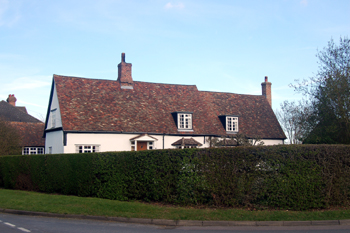
39 Church Road April 2010
39 Church Road was listed by the former Department of Environment in May 1984 as Grade II, of special interest. The department dated the property to the 16th century with 17th century additions and alterations. The cottage is of timber framed construction with colour washed roughcast render and an old clay tile roof. Main block is 2-room, Like 7, 21 and 33 Church Road the building was originally one storey, but has been one storey and attics since the 17th century when a first floor was inserted. Later, slightly lower, blocks lie at the south gable end and to the east, forming overall a T-plan.
The cottage may have been built by a Lord of the Manor. From 1529 to 1731 the manor was owned by the Gostwick family, then the Dukes of Marlborough until 1779 when the manor was purchased by the Duke of Bedford. Alternatively the manorial estate may have bought the cottage at a later date.
In November 1903 then Lords of the Manor, George and James Keeble, put the Willington Manor Estate properties in the village up for sale by auction. The sale particulars [X403/3] included 39 Church Road in Lot 36. The property was then divided into three with another small cottage to the right hand side:
Four Stud and Tiled Cottages
Numbers 18, 19, 20 and 21, situated at the corner of Willington Road [Church Road] and Gravel Pit Road [Balls Lane] being part of Number 38 on the Ordnance Survey Plan, and containing
1 rood, 30 poles
OR THEREABOUTS
The Rating and Valuation Act 1925 specified that every piece of land and building in the country was to be assessed to determine its rateable value. Willington, like most of the county, was assessed in 1927 and the valuer visiting 39 Church Road [DV1/C154/75-77] found it divided into three separate properties.
All were owned by the Misses Preston. The portion closest to the road was occupied by Mrs. E. Mathers and was then numbered 20 The Village. She paid rent of £5 per annum for a living room with a bedroom above.
The middle part of the property, 19 The Village, was occupied by G. Spavins who paid rent of £1/8/- per quarter. Accommodation comprised a living room, a scullery and two bedrooms above.
18 The Village, the rear of the property, was occupied by Mrs. M. Dawkes. She paid rent of £1/2/4 per quarter and her accommodation comprised a living room, a kitchen and one bedroom above.